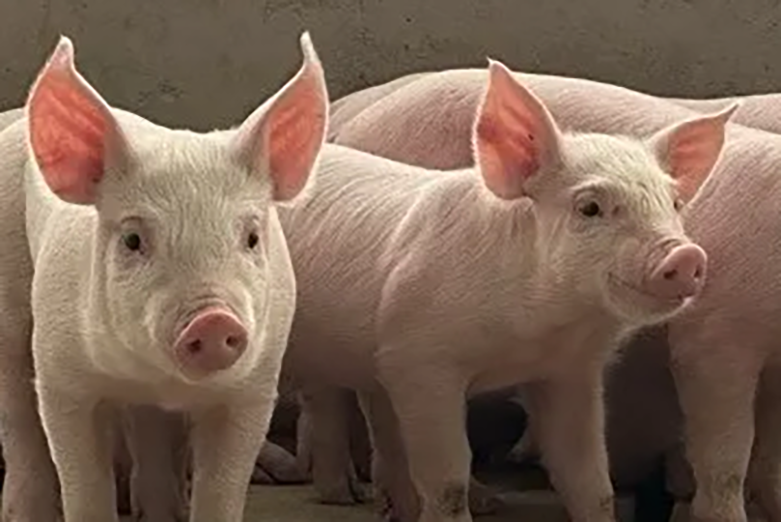This study estimated the genetic parameters for human-directed behaviour and intraspecific social aggression traits in growing pigs, and explored the phenotypic correlations among them. Data on 2,413 growing pigs were available. Pigs were mixed into new social groups of 18 animals, at 69±5.2 d of age and skin lesions (SL) were counted 24 h (SL24h) post-mixing. Individual behavioural responses to isolation in a weighing crate (CRATE) or when alone in an arena while a human directly approached them (IHAT) were assessed within 48h post-mixing. Additionally, pigs were tested for behavioural responses to the presence of a single human observer walking in their home pen in a circular motion (WTP) within one (T1) and 4 weeks post-mixing (T2) noting pigs that followed, nosed or bit the observer. Animal models were used to estimate genetic and phenotypic parameters for all studied traits. Heritabilities (h²) for SL, CRATE and IHAT responses were low to moderate (0.07 to 0.29), with the highest h2 estimated for speed of moving away from the approaching observer. Low but significant h2 were estimated for nosing (0.09) and biting (0.11) the observer at T2. Positive high genetic correlations (rg) were observed between CRATE and IHAT responses (0.52 to 0.93), and within SL traits (0.79 to 0.91) while positive low to high correlations between the estimated breeding values (rEBV) were estimated within the WTP test (0.24 to 0.59) traits. Positive moderate rg were observed between CRATE and central and posterior SL24h. The rEBV of CRATE and IHAT test responses and WTP test traits were low, mostly negative (-0.21 to 0.05) and not significant. Low positive rEBV (0.06 to 0.24) were observed between SL and the WTP test traits. Phenotypic correlations between CRATE and IHAT responses and SL or WTP test traits were mostly low and not significant. Under the conditions of this study, h2 estimates for all studied traits suggest they could be suitable as a method of phenotyping aggression and fear/boldness for genetic selection purposes. Additionally, genetic correlations between aggression and fear indicators were observed. These findings suggest selection to reduce the accumulation of lesions is likely to make pigs more relaxed in a crate environment, but to alter the engagement with humans in other contexts that depends on the location of the lesions under selection.
Desire, S., Calderón Díaz, J.A., Lewis, C.R.G., Roehe, R., Turner, S. P. SRUC (Scotland’s Rural College), Edinburgh, Scotland, UK; PIC Europe, Sant Cugat del Valles, Barcelona, Spain
PIC comment
Julia Adriana Calderón Díaz, Product Development Specialist, PIC Europe
Ensuring appropriate animal welfare is a high priority in modern pig production systems. Pig production has evolved from small family farm to large enterprises. These changes have resulted in lower stock person per animal ratio and therefore, in less opportunities for animals to become habituated to the presence of and being handled by humans when necessary but also impacted the degree of knowledge and care that the handlers have towards the animals.
Animals may become more fearful when interacting with stock personnel which could contribute to chronic stress, possibly affecting social interactions and ultimately production. Indeed, many animal welfare problems in might be mostly related to failures in stockmanship highlighting the importance of positive pig-human interactions. A positive interaction is one characterised by low level of fear and a high level of trust in humans.
The above study used a novel approach to explore pig-human interactions by investigating genetic parameters for temperament and the way they react to their handlers. Heritability (i.e. the quality of a characteristic being transmissible from parent to offspring) estimates for fearfulness (i.e. vocal and physical withdrawal response to an approaching human while isolated in an arena; attempts to escape from a weigh crate); boldness (i.e. biting, following or nosing a human walking inside their home pen) and aggression (i.e. skin lesions) were in a range that suggests they could be suitable as a method of phenotyping aggression and fear/boldness for genetic selection purposes in pigs.
Moreover, genetic associations (i.e. the proportion of the heritability that is shared between two traits) between aggression and fear in pigs were observed as those pigs with more lesions in their belly/back and the hindquarters also displayed more distress while in the weigh crate and were less likely to willingly approach a human. Conversely, pigs with a high number of lesions to the anterior part of the body, also showed an aversive reaction to being in the crate, but these animals were more willing to explore a human in their home pen.
The findings from this study could have practical implications for the pig industry as they suggest that pigs selected for reduced aggression could be easier to handle while performing certain routine farm procedures such as weighing. However, it is important to remember that any selection on behavioural traits needs to be carefully considered as these results are only valid within the context measured. Thus, further research would be needed to make sure any selection to result in a positive change in one aspect of production does not have a negative impact in another area of production.
This abstract review has been originally published in the Spanish journal SUIS.




